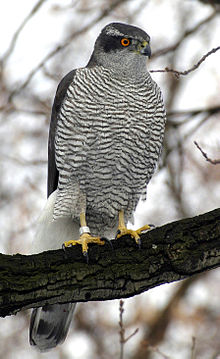Vedrfölnir
Vedrfölnir ( Old Norse Veðrfǫlnir ), also Germanized Wedrfölnir , is a hawk in Norse mythology that sits on the world tree Yggdrasil between the eyes of the eagle there .
swell
This hawk is mentioned in Eddic literature only in Snorri Sturluson's Prose Edda :
“Örn an sitr í limum asksins, ok he hann margs vitandi
en í milli augna honum sitr haukr, sá he is called Veðrfölnir.
Íkorni sá, his name is Ratatoskr, renn upp ok niðr eftir askinum
ok berr öfundarorð milli arnarins ok Níðhöggs,
en fjórir hirtir renna í limum asksins ok bíta barr. "
“An eagle sits in the branches of the ash tree, it has a lot of knowledge
and the hawk named Wedrfölnir sits between its eyes.
The squirrel, called Ratatosk, jumps up and down the ash tree.
It
exchanges venom between the eagle and Nidhögg . "
In the Þulur , Vedrfölnir is a heiti for hawk. That is, a poet could use the name as a synonym for the hawk.
reception
etymology
Old Norse Veðrfǫlnir is composed of veðr “wind, storm, weather” and perhaps for “pale, pale, whitish” or fǫlna “wither, become pale, become pale”. Accordingly, the name Vedrfölnirs is translated as "the bleaching of the storm", "the bleaching of the weather" or "who is bleached by storm and weather".
Linguistically less obvious are name interpretations as “weather maker” or as “disheveled in or by the storm”.
Importance of the hawk
The nobles had a special relationship with the hawks. They trained the birds and used them to hunt . The proximity between the hunter and the bird of prey gave the hawk a high reputation, as the Lieder-Edda attests several times ( Guðrúnarkviða in fyrsta 18; Guðrúnarkviða in önnur 40; Sigurðarkviða Fafnisbana önnur 31). The hawk was so respected that it could even be a symbol of royalty ( Skáldskaparmál 62). It was not for nothing that he was assigned to Odin , the father of the gods, in Norse mythology , as can be seen from the phrase “like Odin's greedy hawks” ( Helgakviða Hjörvarðssonar 42).
interpretation
Since the hawk is located in the eagle's eye, the great knowledge of the eagle seems to be related to the hawk because of the close proximity of both. So it is assumed that he flies out like Odin's ravens and brings back knowledge. However, the hawk's wisdom could simply be of a different or higher quality than that of the eagle. Jacob Grimm points out that the old Norse idiom haukr í horni "hawk in the corner" means a hidden guide. That is why he not only sees the hawk as a friend of the eagle: if the eagle is already considered to be very knowledgeable, how much does it have to be its advisor?
Individual evidence
- ^ Arnulf Krause: The Edda of Snorri Sturluson. Philipp Reclam jun. Verlag, Stuttgart 1997, ISBN 978-3-15-000782-2
- ↑ Þulur, III 50. - Hauks heiti
- ^ Walter Baetke: Dictionary of Norse prose literature. 1st & 2nd edition (digital version). Greifswald 2006 - Gerhard Köbler : Old Norse dictionary. 2nd Edition. 2003 ( online , wikiling Old Norse )
- ^ Andy Orchard: Cassell dictionary of Norse myth and legend . Cassell, London 1997, ISBN 978-0-304-35134-3 , keyword Vedrfölnir: wind-witherer "Wind Welker" - John Lindow: Handbook of Norse Mythology. ABC-CLIO Ltd, USA 2001, ISBN 978-1-57607-217-2 , p. 312: storm-pale “the storm bleach” - René LM Derolez: gods and myths of the Germanic peoples . Benziger Verlag, Cologne 1959, p. 272: "the one discolored by wind and weather"
- ^ So Hansferdinand Döbler: Die Germanen. Gondrom Verlag, Bindlach 1992, ISBN 978-3-8112-0935-0 , p. 146
- ↑ For example with Reiner Tetzner: Germanic legends of the gods (retold according to the sources). Reclam-Verlag, Ditzingen 1992, ISBN 978-3-15-008750-3 , p. 17. Perhaps in the context of the fact that Old Norse veðr comes from the Indo-European root * au- "blow, blow, breath "
- ↑ John Lindow: Handbook of Norse Mythology. ABC-CLIO Ltd, USA 2001, ISBN 978-1-57607-217-2 , p. 312
- ^ Jacob Grimm: German Mythology (3 vol. E). Reprint of the 4th edition, Berlin 1875–1878 by Marix Verlag, Wiesbaden 2007, ISBN 978-3-86539-143-8 , vol. 1, p. 664, footnote 2

